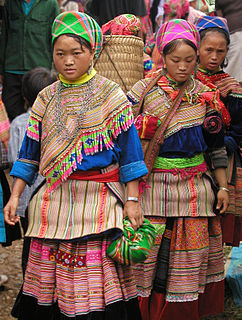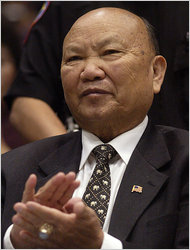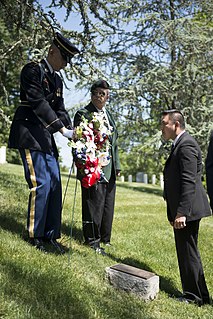
Laos, officially the Lao People's Democratic Republic, is a socialist state and the only landlocked country in Southeast Asia. At the heart of the Indochinese Peninsula, Laos is bordered by Myanmar and China to the northwest, Vietnam to the east, Cambodia to the southeast and Thailand to the west and southwest.

The Hmong/Mong people is an Asian ethnic group in China and Southeast Asia. They are a subgroup of Miao people, and live mainly in southern China, Vietnam, Laos, Thailand, and Myanmar. They have been members of the Unrepresented Nations and Peoples Organization (UNPO) since 2007.

Vang Pao was a major general in the Royal Lao Army. He was a leader in the Hmong American community in the United States.

The Laotian Civil War (1959–1975) was a civil war in Laos fought between the Communist Pathet Lao and the Royal Lao Government from 23 May 1959 to 2 December 1975. It is associated with the Cambodian Civil War and the Vietnam War, with both sides receiving heavy external support in a proxy war between the global Cold War superpowers. It is called the Secret War among the CIA Special Activities Center and Hmong veterans of the conflict.
Wat Thamkrabok is a Buddhist temple (wat) in Thailand, located in the Phra Phutthabat district of Saraburi Province, Thailand.
Hmong Americans are Americans of Hmong descent. Most Hmong Americans are those that emigrated to the United States as refugees in the late 1970s, and their descendants. Some refugees fled Laos due to their cooperation with the United States' Central Intelligence Agency operatives in northern Laos during the Vietnam War. Over half of the Laotian Hmong population left the country, or attempted to leave, in 1975, at the culmination of the war. About 90% of those who made it to refugee camps in Thailand were ultimately resettled in the United States. The rest, about 8 to 10%, resettled in countries including Canada, France, the Netherlands, and Australia. According to the 2010 US Census, the population count for Hmong Americans was 260,000. Hmong Americans face disparities in healthcare, and socioeconomic challenges that lead to lower health literacy and median life expectancy, and per capita income.

Steven Craig Gunderson is the former President and CEO of the Council on Foundations, the current president and CEO of the Career Education Colleges and Universities, and a former Republican congressman from Wisconsin.

The situation of human rights in Laos has often been, and remains, a recognized cause for serious concern. Laos is one a handful of Marxist-Leninist governments and is ruled by a one-party communist government backed by the Lao People's Army in alliance with the Vietnam People's Army and the Socialist Republic of Vietnam in Hanoi.
The insurgency in Laos refers to the ongoing, albeit sporadic, military conflict between the Lao People's Army, and Vietnam People's Army opposed primarily by members of the former "Secret Army" or the Hmong people as well as various other ethnic lowland Lao insurgencies in Laos, who have faced governmental reprisals due to Royal Lao and Hmong support for the American-led, anti-communist campaigns in Laos during the Laotian Civil War—which is an extension to the war itself. The North Vietnamese invaded Laos in 1958-59 and supported the communist Pathet Lao. It continued on the day after the end of the civil war with the Pathet Lao's capture of the Laotian capital Vientiane, who overthrew the Royal Kingdom of Laos and established a new government known as the Lao People's Democratic Republic.

The Hmong and Lao Memorial, or Lao Veterans of America Monument, is a granite monument, bronze plaque and living memorial in Arlington National Cemetery. Dedicated in May 1997, it is located in Section 2 on Grant Avenue between the path to the JFK memorial and the Tomb of the Unknowns, in Arlington National Cemetery, Arlington, Virginia, in the United States. The Laos–Hmong memorial commemorates the veterans of the "Secret War" in Laos who fought against invading Soviet Union-backed North Vietnam Army forces of the People's Army of Vietnam and communist Pathet Lao guerrillas. Approved by the U.S. Department of Defense, Arlington National Cemetery, and the U.S. Department of the Army, but designed and paid for privately by the Lao Veterans of America, Inc., the Lao Veterans of America Institute, and The Centre for Public Policy Analysis, the memorial stands as a tribute to the Hmong, Lao, other ethnic groups, and American clandestine and military advisers who made up the Secret War effort during the Vietnam War. The Lao Veterans of America, Inc. is the nation's largest ethnic Laotian- and Hmong-American veterans organization.

Laos – United States relations officially began when the United States opened a legation in Laos in 1950, when Laos was a semi-autonomous state within French Indochina. These relations were maintained after Lao independence in October 1953.
Vang Pobzeb was a Hmong American dedicated to Lao and Hmong human rights. For over 25 years, he was an outspoken critic of the Marxist governments of the Pathet Lao in Laos and the Socialist Republic of Vietnam(SRV) and their human rights violations, religious freedom violations, and persecution of the Lao and Hmong people.
The Center for Public Policy Analysis (CPPA), or Centre for Public Policy Analysis, was established in Washington, D.C. in 1988 and describes itself as a non-profit, non-partisan, think tank and research organization. The CPPA is a non-governmental organization (NGO) focused on foreign policy, national security, human rights, refugee and international humanitarian issues.

The Indochina refugee crisis was the large outflow of people from the former French colonies of Indochina, comprising the countries of Vietnam, Cambodia, and Laos, after communist governments were established in 1975. Over the next 25 years and out of a total Indochinese population in 1975 of 56 million, more than 3 million people would undertake the dangerous journey to become refugees in other countries of Southeast Asia, Hong Kong, or China. According to the United Nations High Commissioner for Refugees, 250,000 Vietnamese refugees had perished at sea by July 1986. More than 2.5 million Indochinese were resettled, mostly in North America, Australia, and Europe. More than 525,000 were repatriated, either voluntarily or involuntarily, mainly from Cambodia.
The United League for Democracy in Laos, Inc. (ULDL) is a non-profit, non-governmental organization (NGO) based in the Washington, D.C.-area with chapters and members in the United States, Southeast Asia, Thailand and Laos. The ULDL has works to provide information about developments in Laos regarding civil society, human rights, pro-democracy, religious freedom, political prisoners and environmental issues.
The Lao Human Rights Council, Inc. (LHRC) is a non-profit, non-partisan, non-governmental (NGO) refugee and human rights organization. It is based nationally, and internationally, with chapters in Colorado, Wisconsin and Minnesota. The Lao Human Rights Council, Inc. researches, and provides information and education regarding the plight of Laotian and Hmong people, and refugees persecuted in Laos, the Socialist Republic of Vietnam and Thailand. It was founded by Dr. Pozbeb Vang, Vang Pobzeb of Greenbay Wisconsin. The Lao Human Rights Council, Inc. is currently headed by Vaughn Vang, an educator, and former political refugee from the Royal Kingdom of Laos, who is a Hmong-American—and who was born, and grew up, in Laos prior to the North Vietnamese invasion of Laos and Marxist takeover in 1975.

Wangyee Vang is a Hmong-American community leader, educator and elder from Fresno, and the Central Valley, of California.
The Lao Veterans of America Institute (LVAI) is a national non-profit organization based in Fresno, and the Central Valley, of California, with chapters throughout California. It is one of the largest ethnic Lao- and Hmong-American veterans organizations representing tens of thousands of Lao Hmong veterans who served in the Vietnam War in the Royal Kingdom of Laos as well as their refugee families who were resettled in the United States after the conflict.
Ban Vinai Refugee Camp, officially the Ban Vinai Holding Center, was a refugee camp in Thailand from 1975 until 1992. Ban Vinai primarily housed highland people, especially Hmong, who fled communist rule in Laos. Ban Vinai had a maximum population of about 45,000 Hmong and other highland people. Many of the highland Lao were resettled in the United States and other countries. Many others lived in the camp for years which came to resemble a crowded and large Hmong village. The Royal Thai Government closed the camp in 1992, forced some of the inhabitants to return to Laos and removed the rest of them to other refugee camps.
Jane Hamilton-Merritt, in Noble County, Indiana is a retired college professor, photojournalist, author, and animal rights and animal husbandry advocate. She resides in Redding, Connecticut. In 1999, she was inducted into the Connecticut Women's Hall of Fame. Some of her work has focused on breeding and raising Llamas and Alpaca.










